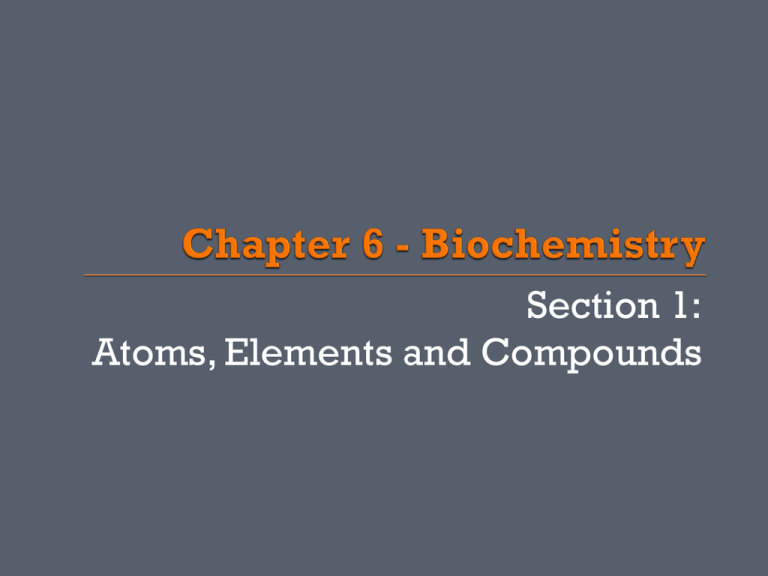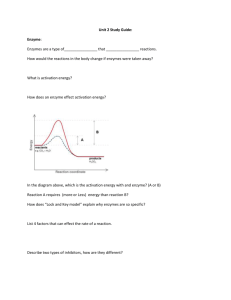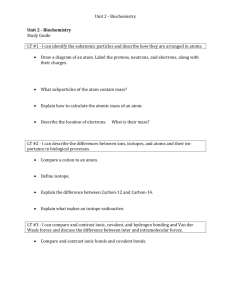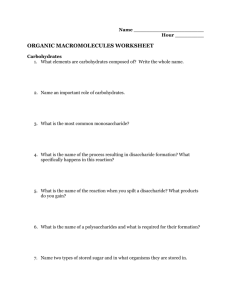Chapter 2 - Chemistry
advertisement

Section 1: Atoms, Elements and Compounds Elements • pure substances that cannot be broken down chemically There are 4 main elements that make up 90% of the mass of living things: • Carbon – C • Oxygen – O • Hydrogen – H • Nitrogen - N Each element has a chemical symbol Atoms are the simplest particle of an element. The properties of atoms determine the properties of the matter they compose Atomic Structure: • Nucleus: the central region of an atom Made of protons (+) and neutrons (neutral) The number of protons in an element = the atomic number • Electrons: have a negative charge that balances the protons • Found in energy levels around the nucleus Energy Level Neutron Proton Electron Nucleus Compounds are pure substances made of two or more elements • Shown in chemical formulas Ex: H2O always 2H for 1O • The goal of making compounds is to make atoms stable Compounds are held together by bonds • Covalent bonds: share electrons • Ionic Bonds: electrons are transferred Results in ions atoms with a full positive or negative charge Create Covalent Bonds Ionic Bonds a Venn Diagram comparing and contrasting Covalent and Ionic Bonds. Stand Up Touch your right elbow to your left knee Then touch your left elbow to your right knee. Repeat 9 more times Section 2: Chemical Reactions Chemical Reactions • the process through which chemical bonds are broken or made (and sometimes both!) 6H2O + 6CO2 + energy C6H12O6 +6O2 Reactants: what you put in Products: what you get out Activation Energy • energy to start a reaction Catalysts • reduce the amount of activation energy. • Enzymes: catalysts found in living things Visual Concept Section 3: Water & Solutions Solution: a mixture in which one or more substances are uniformly distributed in another substance • Solute: the substance dissolved in a solution • Solvent: the substance that does the dissolving Concentration: measurement of the amount of solute in a fixed amount of solution • 2% salt = 2g of salt in enough water to make 100mL • Saturated Solution: is a solution in which no more solute can dissolve Section 4: The Building Blocks of Life Organic Compounds: made mostly of carbon atoms Inorganic Compounds: do not contain carbon Carbon itself: can bond with • It can form straight chains • It can form branched chains • It can form rings Monomers: building blocks of organic molecules Polymer: molecule made of multiple monomers that are linked together Macromolecules: large polymers • Ex: carbohydrates, lipids, proteins and nucleic acids Condensation Reaction: monomers are linked to polymers and water is released Hydrolysis: break down of polymers using water • The reverse of a condensation reaction 4 Molecules of Life • Carbohydrates (sugars) • Proteins (enzymes) • Lipids (fats) • Nucleic Acids (DNA and RNA) Carbohydrates Organic compounds made of carbon, oxygen and hydrogen. Monosaccharides: monomer (building block) of a Glucose carbohydrate Examples: Glucose & Fructose ○ All 3 monomers have the same formula C6H12O6, but they each have different structures - isomers Fructose Disaccharides: double sugar (two monosaccharides bonded together) • The reaction that joins the two monosaccharides together is called a condensation reaction • Examples: Sucrose Lactose Sucrose Polysaccharides: made of 3 or more monosaccharides bonded together • Examples: Glycogen (in animals): energy storage Stored in liver and muscle, made of glucose molecules Starch (in plants): energy storage Made of glucose molecules Cellulose (in plants): used for structure cell wall Proteins • organic compounds made of carbon, hydrogen, oxygen and nitrogen Monomer = amino acids • 20 different amino acids • Functional groups of amino acids: -COOH, NH2 • What gives the amino acid its specific identity is it’s R-group R-groups can be simple or complex Dipeptides are two amino acids bonded together • The bond between amino acids is called a peptide bond • Peptide bonds are formed during a condensation reaction Polypeptides: very long chains of amino acids Form larger proteins, which are usually made of more than one polypeptide chain Enzymes: Protein (or RNA) molecules that act as biological catalysts Temperature and pH effect an enzyme’s activity How enzymes work: • Induced Fit Model of Enzyme Action Enzyme reactions depend on the physical fit between the enzyme and its substrate (the reactant being catalyzed) Active Site: portion of the enzyme that the substrate fits into The linkage between the enzyme and the substrate causes a slight change in the enzyme’s shape which puts a strain on the substrate bonds The enzyme releases the products and remains unchanged Lipids: large, nonpolar molecules • DO NOT dissolve in H20 organic Building blocks of lipids: • Glycerol: Functional group = -OH • Fatty Acids: unbranched carbon-chains Functional group = -COOH • Fatty Acids Continued: Fatty acids can be saturated (each carbon is bonded to 4 other things – “full”) Fatty acids can be unsaturated (when the carbon atoms form double bonds with each other in the carbon chain) Types of Lipids: • Triglycerides: 3 fatty acids attached to a glycerol • Phospholipids: 2 fatty acids attached to a glycerol, with a phosphate attached to the 3rd carbon of the glycerol Makes-up the cell membrane of cells Hydrophilic head 2 Fatty acid tails Nucleic Acids: store and transfer genetic information • 3 parts of a nucleic acid: Phosphate Group Sugar Nitrogenous Base • Three combined forms the nucleotide • 2 types of Nucleic Acids DNA: stores genetic information for an organism RNA: stores and transfers information from DNA that is needed to make proteins







